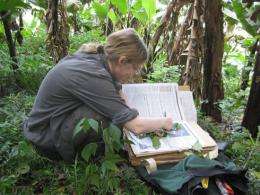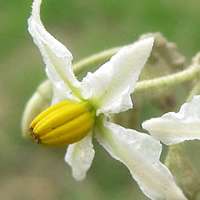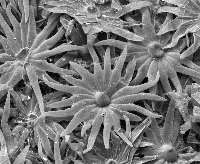Hunt for African spiny aubergine begins

(PhysOrg.com) -- It's not all looking down microscopes for the work of a Natural History Museum scientist. Plant expert Maria Vorontsova is on the hunt for wild spiny aubergines in Africa and recording her daily activities in a new NaturePlus blog.
So far, Maria has climbed up 2 mountains, taken a 5-metre fall and seen the strange sausage tree. She has also found out how some aubergine species help farmers keep away the ants and how climate change may be affecting the growing seasons.
'It is amazing to be able to tell the world about things that are important to me,' says Maria. 'The Tanzanian flora is so poorly known and so endangered, I want everyone to know so we can all help preserve it.'
Species of aubergine
Maria is searching for some of the 29 species of wild spiny aubergines that exist in Tanzania, and not the common cultivated aubergine, or eggplant, on sale in shops around the world, which comes from just one species called Solanum melongena.
The Solanum genus of plants, which the aubergine belong to, is extremely important worldwide and includes many other vital food crops such as potatoes and tomatoes.
There are many Solanum specimens in the Museum's world-class botany collection. However, there are always gaps to fill and Maria's work should help with this, as well as increase scientists' understanding of this essential plant group.

Solving puzzles
Maria has already cleared up one puzzle. In the Museum, Maria works from a collection of sheets of preserved pressed plants (herbarium) and wanted to find out if 2 similar looking plants were the same species or different.
Already, out in Tanzania, she has found the 2 species growing side by side and was able to confirm the differences and that they are indeed separate species.
Difficulties of identification
Identifying the differences between 29 species is not an easy task. Branches and leaves can look quite similar but the key is finding flowers, fruit or having a microscope to look at the tiny stem hairs. The flowers and fruit should appear in the rainy season, in March, but Maria had to wait until the very last day of March for the rains to begin properly.

Another factor that didn’t help identification was goats, as Maria found out when she was searching for one particular species. Local people told her that as soon the flowers and fruits appear, the goats eat them!
Maria's research trip began last month and she is also travelling to Kenya. So far her team has found some of the aubergine species they were looking for, some that are only found in Tanzania (endemic) and Maria also hopes to find 3 new species. Follow her blog to get regular updates.
More information: Maria Vorontsova's Wild spiny aubergine hunt blog in NaturePlus - www.nhm.ac.uk/natureplus/blogs/wildspiny
Provided by American Museum of Natural History

















